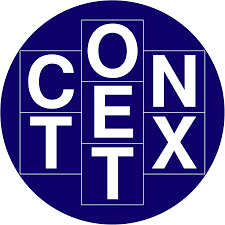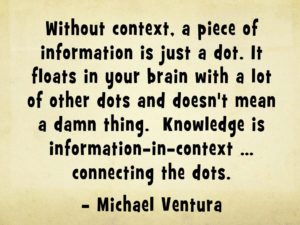 Several months ago I was sitting in a large conference room, listening to a presentation of a leader in a major non-profit. He looked good. He carried himself well. His speech was precise. His tone was easy to listen to.
Several months ago I was sitting in a large conference room, listening to a presentation of a leader in a major non-profit. He looked good. He carried himself well. His speech was precise. His tone was easy to listen to.
I was all ears.
And then he started his PowerPoint presentation, and the droning began. There were a lot of words and a lot of detail. And while that was disturbing and distracting, the major problem for me and the audience listening was that we didn’t know where he was going.
He had just started into the subject. It soon became obvious that the way he had organized his presentation was to explain the reasoning behind his position or conclusion, without first telling us what that conclusion was. He had not set context. The result was that all of his detail was lost to the audience, because no one in the room knew where he was going.
So those precious points, many of them very good, did not turn into the building blocks he wanted. By the time he got to the end of his presentation he had made five points leading up to his conclusion, and we had all forgotten most of the points or could not remember what sequence they were in. Which leads me to this quote:

I hear too many speeches, sit in too many meetings, and receive too many communications (written and electronic) where the author starts off by building the case and only later gets to the reason for building it.
Picture this:
You’re building a house, and you have asked an architect to submit some initial designs and concepts. She says she is ready to present, so you sit down with her, eagerly anticipating what she has come up with.
Architect: “What I thought I would do is give you the rationale for cement vs. brick. It is really important to understand this.”
You: (thinking) “Why is she bringing this up? Where is she going?”
Architect: “Cement will be much more stable in this situation.”
You: (still thinking) “What situation? Where are we going?”
And after the conversation goes on for a while you finally interrupt and say: “I think we need to start over. Give me context. Let’s start with your concept and design, and THEN get into why you are making a case for cement.”
Your architect does that. Now you finally understand that she is concerned about the viability of the structure just above the foundation, and that is why she is talking about cement vs. bricks.
Jeff and I have seen so many proposals, speeches, emails and presentations where the donor cannot possibly make sense of what is being communicated – because the authors started from a place that does not set context in a way that matters to the donor. The result? The donor is confused.
So what is the best way to figure out the right context for your caseload donor, especially if you are in the process of creating an ask?
Stop for a second and think about this. What is the context that matters to the donor on your caseload? What matters to the donor?
What matters to the donor is what is buried in her head and heart – her interests and passions.
So if the donor has a deep hunger to DO something for homeless kids, then your STARTING place in the conversation, the proposal, the communication is there.
It is not about your organization and all of its processes in dealing with homeless kids. It is not about the philosophy or operating principles of dealing with homeless kids. It is not about how you are more effective than others in dealing with homeless kids.
Nope, none of that. Your starting place is the donor’s passions and interests.
It sounds like this: “Mary [the donor], I know that one of your deep, deep concerns and passions is to help homeless kids. That is what I want to talk to you about.”
Setting context.
And then you go into the problem and the believable solution – i.e. what you are going to DO to solve the problem.
So if you want to confuse your donor, or anyone else receiving your verbal, written or electronic communication, then don’t start with context. Just jump in and start writing or talking. That will get them confused.
Or, you can adopt the rule I try to follow – context first. Here are some pointers in different settings, all of which you can apply to communicating with your caseload donor and your other communications, both personal and professional:
- Starting an email: state your conclusion or what you want, then develop the “case.”
- Starting a meeting: begin by saying “The objective of this meeting is _________.”
- Starting a persuasive conversation: let him/her know what you’re wanting, then get into your rationale.
- Starting a presentation: state your conclusion, then explain why it makes sense.
So many communication situations, both personal and professional, are just dots with no connection anywhere. They are clouded by detail and process first, and then followed by conclusion or objective. This is why the listener (donor) is confused, bored or impatient.
Change this in all of your communication. Give context first.
Richard






What is your take on when you are presenting to a corporate donor? While I know you are still talking to a person, that person is representing a company which might have very generous philanthropic goals. Are they more interested in the trustworthy-ness of the charity? (ie talk about how good we are?) When should that piece of the conversation happen? Or is it truly needed? What if the corporation is new to you? Ie this is a first presentation?
You may have to build credibility first, i.e. this is who we are and why it is good to spend time with me/us and listen to what we want to say. You MAY have to do that. But I would start with context first. So it could sound like this: “I was looking at your CSR (Corporate Social Responsibility) objectives and believe we have a perfect match for what you want to do in the community and what we are doing. That is the objective of this meeting. I want to tell you what we do and how it matches your CSR objectives. I also want to tell you why we are a good partner for you.” Something like that, which weaves in the credibility piece. Remember, they don’t care as much about you until you show them that what THEY want to do is what you can deliver.
Thank you! We have a “standard” powerpoint that has been created based on past templates and I desperately want to find a different way to weave in the credibility piece. Our “always done this way” presentation starts with info on our hospital (we’re the best!) then info on the foundation (we have funded this great stuff – oh with the help of donors), then info on the project – a case for support but so far, no personal impact moments I can find. Eventually, we say what the cost of the project is and what the impact of a gift will be – it’s so sterile, even for corporates! There must be a more impactful way to tell this story, even for corporate presentation – and especially when we start bringing individual donors through.